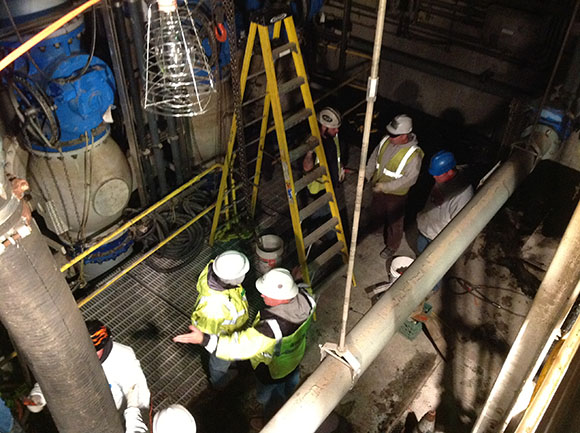 |
 |
| current issue |  |
past issues |  |
send a letter/news |  |
address update |  |
advertise |  |
about us |  |
alumni home |
Reaching Out stories
Public Health "Time Bomb"
Kevin Donnelly '81 was called on to bring a submerged wastewater treatment plant in Queens back online.
By Andrew Leibs '87G
In 2004, as Hurricane Jeanne looped back to threaten his operations base at Camp Lucie Blue, Kevin Donnelly '81 stepped out, glanced at the Florida sky, and had an epiphany. "I felt like everything I'd done in my life—Boy Scouts, my civil engineering degree, Air Force survival training—had prepared me for this moment," recalls Donnelly. Still, he didn't expect that managing FEMA teams who were deploying roof tarps and trailers would call on his martial arts skills (to calm himself, not kick) or that the best way to communicate during similar post-Katrina recovery projects would be dispatching runners with hand-written notes. Donnelly thrives on being the type of leader people look to during a disaster, a role he describes as, "having a presence that makes others feel you've got it under control—even if internally, you're saying, 'Holy shit!'" So when Hurricane Sandy hit New York City, the Department of Environmental Protection dispatched him to recover a submerged wastewater treatment plant—a logistical locked-room puzzle and ticking public health "time bomb"—in Rockaway. "No one could have imagined the magnitude," says Donnelly, now assistant commissioner of the DEP's Wastewater Capital Program. When Sandy struck, Donnelly was managing capital programs for the city's 14 treatment plants, 96 pump stations, and three major combined sewer-overflow facilities—one of the nation's largest wastewater utilities. The storm surge flooded the underground tunnels connecting the plant's buildings and process tanks; saltwater destroyed every pump motor and electrical component; downed pipes blocked the only access to key controls—a total shutdown. "When pumps fail, water rises in the wet well and starts dumping into the bay," says Donnelly. "Downed pump stations can force water to back up into homes, or leach into the groundwater. Both pose major health risks." Donnelly's teams had to pump out all the water, assess damages, and see what could be restored. He kept a crane on standby 24/7 to lift things over fallen pipes. Three weeks of round-the-clock rerigging got the plant back online. "We're not out of the woods, but we are over the hump," Donnelly says. It's common for big storms to compromise one plant or station, Donnelly says. But Sandy took out 30 of the 96 pump stations Donnelly oversees and strained every resource and respondent: backup generators weren't sized for long power outages; troubleshooting and ordering new equipment, such as industrial-sized breakers stressed the supply chain; and downed cell towers made spotty phone coverage. The strains got personal as well. "Many of our guys lost their homes or cars," says Donnelly, who nearly lost his city car when a 150-foot oak fell from across the street onto his Floral Park home. He'd moved the car earlier and had to drive over downed power lines on his neighbor's front lawn to get back out. Getting his people to work became a daily recovery project. Sandy took out tunnels. Gas shortages tangled traffic. "People could get to work, but then didn't have enough gas to get home," Donnelly says. "A lot of energy went into figuring out how to get gas to our people." To ease congestion, Mayor Michael Bloomberg limited bridge traffic to cars carrying at least three passengers. Suddenly, getting a critical controls engineer from New Jersey where he was needed became a struggle. Donnelly managed by posting people on bridges and arranging police escorts.
At times, the tasks seemed endless, though Donnelly has learned that assigning them and scheduling progress reports is one key to reducing stress during disasters. "People are looking for a confident someone who can say, 'Let's do this,' Donnelly says. "When people just start doing something, making midcourse corrections is easy." In addition to his daily cleanup and restoration issues, Donnelly still had to manage the delicate mechanism ensuring wastewater's ceaseless, citywide flow. Gravity does much to move muck from residences to the nearest treatment plant. Where flow is impeded, a pump station gets it over the next hill. The waste enters the wet well and is pumped into the primary tank. Hydraulics carry water through the rest of the plant, while additional pumps push the solids along. Plants and stations must respond to different flow rates (which increase with precipitation) during the day. "Pump too fast and the wet well sucks air; too slow, and water backs up," says Donnelly. "You've got to be constantly vigilant on everything." That got tougher in December when Mayor Bloomberg asked Donnelly's boss to lead the FEMA homeowner services initiative called New York City Rapid Repairs, elevating Donnelly to assistant commissioner of the DEP's Bureau of Engineering, Design & Construction. Rockaway wasn't Donnelly's first plant recovery. In July 2011, he was incident commander when fire ravaged the North River Plant on the Hudson River. Like Rockaway, restoration was a three-week, round-the-clock operation. He'd just gotten all the wiring redone when Sandy hit. "The plant's top elevation is supposed to be above the 100-year flood level," says Donnelly. Sandy's surge brought water to within inches of it; pressure blew out seals in the concrete and filled the entire drywall. "Fortunately," Donnelly says, "we got enough pumps in there to keep ahead of the water." ~ Return to Reaching Out stories |
blog comments powered by Disqus



